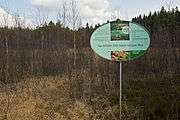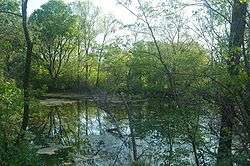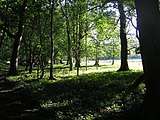Natura 2000
Natura 2000 is a network of nature protection areas in the territory of the European Union. It is made up of Special Areas of Conservation and Special Protection Areas designated respectively under the Habitats Directive and Birds Directive, respectively. The network includes both terrestrial and Marine Protected Areas.
| Founded | 1992 |
|---|---|
| Type | Network of nature protection areas |
Area served | European Union |
| Website | ec |
History
In May 1992, the governments of the European Communities adopted legislation designed to protect the most seriously threatened habitats and species across Europe. The Habitats Directive complements the Birds Directive adopted earlier in 1979 and together they make up the Natura 2000 network of protected areas.
The Birds Directive requires the establishment of Special Protection Areas for birds. The Habitats Directive similarly requires Sites of Community Importance which upon the agreement of the European Commission become Special Areas of Conservation to be designated for species other than birds, and for habitat types (e.g. particular types of forest, grasslands, wetlands, etc.). Together, Special Protection Areas and Special Areas of Conservation form the Natura 2000 network of protected areas.
Furthermore, the Natura 2000 network is the EU contribution to the "Emerald network" of Areas of Special Conservation Interest set up under the Bern Convention on the conservation of European wildlife and natural habitats. Natura 2000 is also a key contribution to the Program of Work of Protected Areas of the Convention on Biological Diversity.
As prerequisite for becoming EU member, accession states have to submit proposals for Natura 2000 sites meeting the same criteria as EU member states. Some new member states have large areas which qualify to be protected under the directives and implementation has not always been simple.[1]
The Natura 2000 sites are selected by member states and the European Commission following strictly scientific criteria according to the two directives mentioned above. The Special Protection Areas are designated directly by each EU member state, while the Special Areas of Conservation follow a more elaborate process: each EU member state must compile a list of the best wildlife areas containing the habitats and species listed in the Habitats Directive; this list must then be submitted to the European Commission, after which an evaluation and selection process on European level will take place in order to become a Natura 2000 site.
The Habitats Directive divides the EU territory into nine biogeographic regions[2] each with its own ecological coherence. Natura 2000 sites are selected according to the conditions in each biogeographical region, thus selected sites represent species and habitat types under similar natural conditions across a suite of countries.
Each Natura 2000 site has a unique identification form called a standard data form. This form is used as a legal reference when assessing the management of the species and habitats through the concept of favourable conservation status. The Natura 2000 Viewer [3] is a tool to explore the network and gives access to every standard data form.
Current status
Natura 2000 protects 27,312 sites with terrestrial area 787,606 km2 (around 18 percent of land of the EU countries) and marine area 360,350 km2 in 2017,[4] and is considered almost complete in the EU terrestrial environment. The process of designation has not always been smooth as the infringement procedures against member states show.[5] While designation of sites may be near complete, the management and enforcement of protection on sites is less advanced and many sites lack management plans.[6] Natura 2000 faced criticism from developers, farmers and politicians who fear that the conservation of habitats and species places a brake on development.[7]
251,564 km2 had been designated as Natura 2000 in the marine environment in 2013. The network in marine areas is not considered complete and acknowledged by the Commission as a “key challenge for EU biodiversity policy in the coming years”.[8]
Natura 2000 sites can vary considerably in character. They are not strictly protected in terms of how they are allowed to be used by people. Many sites are farmed, forested and some are even in urban areas. Other areas are much wilder. The European Commission developed guidelines on the relation between Natura 2000 and wild areas which are thought to make up around 13% of the network.[9] This was in response to a report by Members of the European Parliament in 2009 which called for further protection of Europe's wilderness.[10]
 Sign identifying a "Natura 2000 area" (Haslauer Moor nature reserve) in Austria
Sign identifying a "Natura 2000 area" (Haslauer Moor nature reserve) in Austria Sign identifying a Natura 2000 site in Belgium.
Sign identifying a Natura 2000 site in Belgium.- Sign identifying a "European protected area" (Special Area of Conservation Lieberoser Endmoräne und Staakower Läuche) in Germany
- The Foloi oak forest in Greece is a Natura 2000 site.
- Castro Verde, Natura 2000 site in Portugal
 Natura 2000 locality in Slovakia
Natura 2000 locality in Slovakia

 The Oostvaardersplassen is a Natura 2000 site in the Netherlands.
The Oostvaardersplassen is a Natura 2000 site in the Netherlands.
Raising awareness about Natura 2000 amongst the general public
The Natura 2000 network is not well known among European Union citizens; only 11% of citizens knew what it was in 2013.[11] As part of the EU Biodiversity Strategy, the European Commission committed to raise awareness about the network and biodiversity in general with the public.
In general, Natura 2000 Sites are seen like an interdiction for developing for most of the citizens. Since appeared in some area, the citizens saw only limitations and interdictions without any local advantages for the specific area. The confusion is even greater since in the designation process as a Natura 2000 Site, the local communities were not involved. The documentations for different areas were done by different NGO not belonging to specific areas without out knowing the areas, with limited studies and ignoring the local communities interests. Due to this lack of awareness, most citizens do not know the consequence of belonging to a Natura 2000 Site.
Natura 2000 Day
In order to raise awareness about the Natura 2000 network, 21 May has been designated “Natura 2000 Day”. This precedes “International Day for Biological Diversity” on 22 May. The initiative came from SEO/BirdLife who sought and received funding from the EU LIFE+ programme in order to improve the knowledge of this network.[12]
In 2013, the first Natura 2000 day took place with the aim to raise awareness of citizens about the importance of Natura 2000 network in their lives. Since then, every May 21 and the weeks before, awareness actions take place all over Europe. For example, in 2014, school children and politicians across the EU were encouraged to make a butterfly gesture and post photos on social media to raise awareness.[13]
The Natura 2000 Award
The Natura 2000 Award [14] was launched by the European Commission in 2013, with the first prizes awarded on Natura 2000 Day in 2014. The annual Award aims to raise awareness about the Natura 2000 network, showcase excellence and encourage networking between people working on Natura 2000 sites.
It awards prizes to those working on the management of or to raise awareness about Natura 2000 in five award categories: Conservation; Socio-Economic Benefits; Communication; Reconciling Interests and Perceptions; Cross-Border Cooperation and Networking. In its first year, winners were selected from Bulgaria, Romania, Czech Republic, Belgium and Spain.
Controversy
The Natura 2000 legislation, notably with its habitats-test (or: habitats assessment, Article 6 of the Habitats Directive), dates back to the days climate change was not an issue and the concept of ecosystem services had not been well developed. Hence, in international law literature Kistenkas raised the question the habitats assessment was originally not designed for striking a balance of all relevant ecosystem services or to involve climate change into the assessment.[15] Although well protecting nature conservation objectives, a rethinking of the habitats assessment might be necessary in the light of a new climate law as part of e.g. the EU Green Deal.[16]
In European law literature Borgstrom and Kistenkas have discussed some possible future incompatibilities of the Natura 2000 habitats-test with novel EU Green Infrastructure policies.[17]
In the late 2010s the habitats assessment was at the basis of the so called Nitrogen Crisis (Stikstofcrisis) in The Netherlands as the EU Court (C-293/17 and C-294/17, ECLI:EU:C:2018:882) ruled on agriculture nearby Natura 2000 sites.[18]
In some other member states, such as Bulgaria, there was criticism a project had not been well communicated in advance. This led to construction in the Kaliakra zone of Bulgaria, including wind turbines and a golf course. Land owners have then been told they may not use their land in certain ways, otherwise non-compliance procedures would be used against Bulgaria. This led to protests by the land-owners.[19]
References
- Peter Abran (Jan 2012). "Forest management in the Natura 2000 ecological network in Romania – present problems and perspectives". Rev. pădur. (in Romanian). 127 (1): 21–27. ISSN 1583-7890. 16782. Retrieved 2012-05-08. (webpage has a translation button)
- Natura 2000 Habitats Directive Sites according to Biogeographical Regions last retrieved 31-10-14
- Natura 2000 network viewer last retrieved 31-10-14
- Natura 2000 Barometer last retrieved 14 July 2017.
- European Commission website last retrieved 31-10-14
- "On the Road to Recovery?" (PDF). Retrieved 7 May 2017.
- Beunen, Raoul; Van Assche, Kristof; Duineveld, Martijn (2013). "Performing failure in conservation policy: The implementation of European Union directives in the Netherlands". Land Use Policy. 31: 280–288. doi:10.1016/j.landusepol.2012.07.009.
- European Commission Natura 2000 in the marine environment last retrieved 31-10-14
- European Commission Wilderness in Europe last retrieved 31-10-14
- MEPs Respond to Call to Protect Europe last retrieved 04-02-09
- "Attitudes towards Biodiversity. Flash Eurobarometer 379" (PDF). Retrieved 7 May 2017.
- "Project Life Activates your true wealth". Archived from the original on 4 December 2016. Retrieved 7 May 2017.
- "Natura 2000 Day". www.natura2000day.eu. Retrieved 7 May 2017.
- "European Natura 2000 Award - European Commission". ec.europa.eu. Retrieved 7 May 2017.
- Frederik Hendrik Kistenkas, Innovating European nature conservation law by introducing ecosystem services, GAiA 23/2 (2014): 88-92
- Frederik Hendrik Kistenkas, Rethinking European Nature Conservation Legislation: Towards Sustainable Development, Journal for European Environmental & Planning Law (JEEPL) 2013 10/1 72-84, https://brill.com/view/journals/jeep/10/1/article-p72_6.xml?lang=en, DOI: https://doi.org/10.1163/18760104-01001005(subscription+required)
- Suvi Borgström, Frederik H. Kistenkas, 'The Compatibility of the Habitats Directive with the Novel EU Green Infrastructure Policy' (2014) 23 European Energy and Environmental Law Review, Issue 2, pp. 36–44. http://www.kluwerlawonline.com/abstract.php?id=EELR2014004
- Frederik H. Kistenkas, Harm C. Borgers, Machteld E.A. Kistenkas, Recht voor de groene ruimte, 3rd ed., Wageningen Academic Publishers 2017
- "The Kaliakra protests: The Bulgarian People vs. The EU". Archived from the original on 2018-10-22. Retrieved 2017-08-11.
Documentation
- Natura 2000 : Protecting Europe’s biodiversity, published on 2008/11/11, in English digital book or in paper book (ISBN 978-92-79-08308-2).
See also
External links
| Wikimedia Commons has media related to Natura 2000. |
- Official website
- Natura 2000 Viewer - interactive map (European Environment Agency)
- Natura 2000 data download – the European network of protected sites (European Environment Agency)
- Natura 2000 newsletter (English, French, German, Spanish, Italian)
- Natura 2000 Award
- Natura 2000 Award Scheme - Environmental Benchmarking Report, 2015
- European Topic Centre on Biological Diversity
- Natura Network Initiative – Natura 2000 at work
- A–Z Areas of Biodiversity Importance: Natura 2000
- Natura 2000 and Marine Environment
- List of webpages Natura 2000 of member states of the European Union
- Germany
- Natura 2000 in the global context